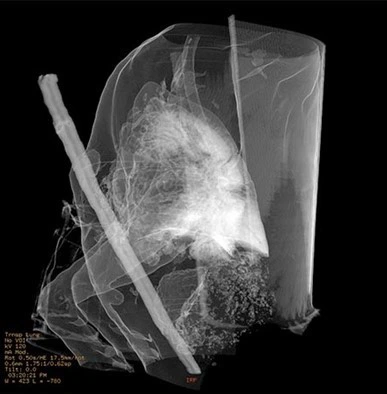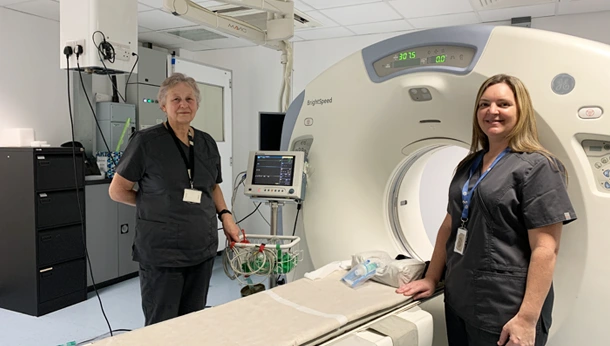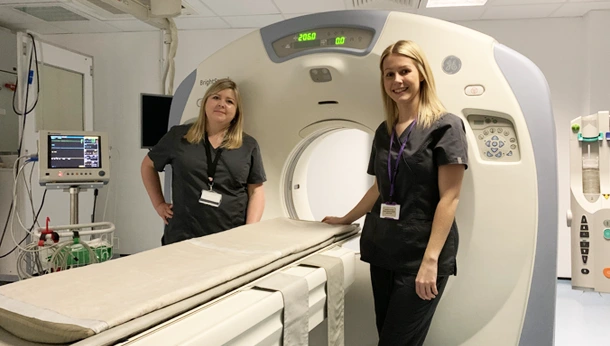As well as a fantastic team of vets and nurses, the referral service is supported by a number of teams to ensure the smooth running of the hospital.
We spoke to the radiography team to find out more about their work, typical day and what made them choose their line of work
Ella Gretton BSc (Hons) Diagnostic Radiography, Radiography Manager
Why did you choose this line of work?
I trained as a human radiographer through the University of Derby and worked across the Nottingham University NHS Trust hospitals. As part of my degree, I completed a three-week elective placement at Pride Veterinary Centre in the CT and MRI department, which I thoroughly enjoyed and did not want to leave. From an early age, I have always loved being around animals, and I really enjoy my job as a radiographer, so to marry the two was my dream role.
Veterinary radiography is an extremely rewarding career. We can see an injured or unwell patient arrive in our department and walk away from the hospital a few days later on the road to recovery.
The expertise of the clinicians and nursing team coupled with the facilities we have at Pride Veterinary Centre are exceptional. It is great to be part of such an amazing clinical team.
How do you support the radiologists?
We work very closely with the radiologists and have a great working relationship with them. We acquire scans on the CT and MRI scanners and send the images over to the radiologists, who then, in turn read the scans and issue a report on their findings.
We discuss new or alternative protocols with the radiologists to ensure that the patient receives the best service in advanced imaging.
What does a typical day look like within imaging?
No two days are ever the same in the diagnostic imaging world. When we arrive in the morning, we run quality assurance checks on the machines and ensure that they are safe to operate for our patients and check our helium levels on the MRI machine. While we are setting up the department, the referral teams are planning their day. We are a reactive department and acquire studies for scheduled CT’s and MRI’s as well as emergency requests.
We offer a 365 day out of hours emergency service which is covered on a rota basis by all our radiographers.
We run the CT and MRI machine throughout the day to acquire the best images for our radiologists to report and help diagnose the current condition for the patient.
You are responsible for the machines – Tell us about your level of responsibility and what it entails?
The CT and MRI machines are the most expensive tools in the hospital however, with each expensive piece of equipment comes an elevated risk.
The CT machine produces Ionising radiation (x-rays) to acquire the images, and the MRI machine room has a huge magnetic presence. The MRI room is the most dangerous room in the hospital. We operate a strict working environment to ensure that only the appropriately trained clinical staff are present within the controlled area which serves the MRI machine and CT machine. Clinical staff undergo further training to enter the MRI room and complete a safety questionnaire to rule out any potential risks. The registered owners of each patient will also complete an MRI safety questionnaire to ensure that it is safe for them to enter the room - The safety questionnaire is remarkably like the questionnaire that a human patient would complete.
All radiographers are responsible for the operating and general housekeeping of the machines. We have maintenance contracts with machine providers who perform regular planned maintenance, of which the engineers are highly skilled within their own fields. Should we have a fault or an issue with either of the machines, we have a fast response contract to ensure that the machine is back up and running as quickly as possible.
What imaging case stands out the most?
A popular and very unfortunate case that stands out for us as a team in CT is Molly. Molly, the black Labrador, was impaled by a 1 metre long stick, whilst out walking.

The team performed an emergency CT scan of Molly’s neck and thorax region. Using the reconstruction facility on the CT scanner, it allowed the surgeons to see the extent of the stick injury and help towards planning surgery and the successful removal of the stick.
Level of equipment on offer at Pride Veterinary Centre
We have a high-field 1.5 Tesla MRI scanner, which uses a magnetic field and radio frequency to show the body’s internal structure. Common indications include imaging of the brain and the spine for evaluation of neurologic disorders.
Our 16 Slice GE BrightSpeed Elite CT scanner gives us a 3D image when a conventional x-ray does not show sufficient information. CT has a broad range of applications in small animal.
For dynamic and functional imaging, we have a GE Fluorostar 7900, which is also known as a fluoroscopy machine or a c-arm system. The fluoroscopy machine uses x-rays to produce a real-time moving image of the patient’s body. It is particularly useful to determine the cause of regurgitation and to perform interventional radiology. All radiographers are trained to use the fluoroscopy machine whilst training while at university. This is another skill that can be applied to both human and veterinary medicine.
Outline future plans for the department
We are always looking to develop our skills and undertake CPD as part of our diagnostic radiography registration. We are currently looking at upgrading several pieces of equipment within the advanced imaging department and we will hopefully have more news on this soon. All I can say now is ‘watch this space’ for future developments on making our department bigger and even better!

Pictured: Andreanna Williams and Ella Gretton
Andreanna Williams DCR MSc, Radiographer
Why did you choose this line of work?
Strangely enough when I was 11 years old, I wanted to be a vet or a nuclear physicist. I always had a love of animals, and my parents were very tolerant of me bringing home injured animals and birds. As I got older, I also found I cared about human illnesses too.
I used my love of physics and maths to decree my unusual direction of career. I failed to be the first female to enter Devonport Dockyard working on the nuclear submarines, so I chose radiography as a career. Upon graduating, I found a job in the nuclear medicine department. After two children and several years, I became the 3rd radiographer in Great Britain to work on research into Positron Emission Tomography (PET) in London - an amazing job using multi-slice technology. I went between PET and MRI and gained my MSc in Medical Imaging.
I wanted to downsize from the hectic London life and saw the vacancy advertisement for Pride Veterinary Centre Advanced Imaging as they were opening in 2011. I thought to myself ‘my dream job’- MRI using the Hydrogen atom in our bodies and more animals than I could ever hope to own! I was lucky enough to get a part-time post and have enjoyed the challenge of imaging animals instead of humans for the last 10 years. So even though I am now past retirement age, I feel young enough to continue this amazing job with all the wonderful staff.
Lisa Brunelleschi BSc (Hons) Diagnostic Radiography, Radiographer
The best thing about working at Pride Veterinary Centre
It is very fulfilling, rewarding and challenging. Every day is a school day, different animals, diseases and conditions keep us on our toes. Maintaining mental flexibility, with lateral thinking is an absolute must. The staff are amazing, and we all work here for the love of the patients and their health.

Pictured: Lisa Brunelleschi and Natalie Howell
Natalie Howell BSc (Hons) Diagnostic Radiography, Radiographer
Why did you choose this line of work?
I always wanted to work in health care and wanted a career that bought variety with it; that’s where diagnostic radiography came in! I spent two days work experience at a hospital in Nottinghamshire and loved the diversity of the job role. Seeing all sorts of injuries, listening to people's stories and witnessing how imaging could be used to aid treatment and could change a patient’s life is incredibly satisfying. It is a very hands-on and demanding job but rewarding in so many ways.
The best thing about working at Pride Veterinary Centre
It is so lovely to see a patient’s recovery and how their quality of life is so much better after we have scanned them, and when they have undergone the necessary treatment they required. You do feel like you have helped them in their road to recovery and it gives you a sense of pride. The teams we work with within imaging are fantastic! Each day is a school day here and there are so many interesting cases we see and scan. Plus, all the cuddles we get from the patients is a bonus!